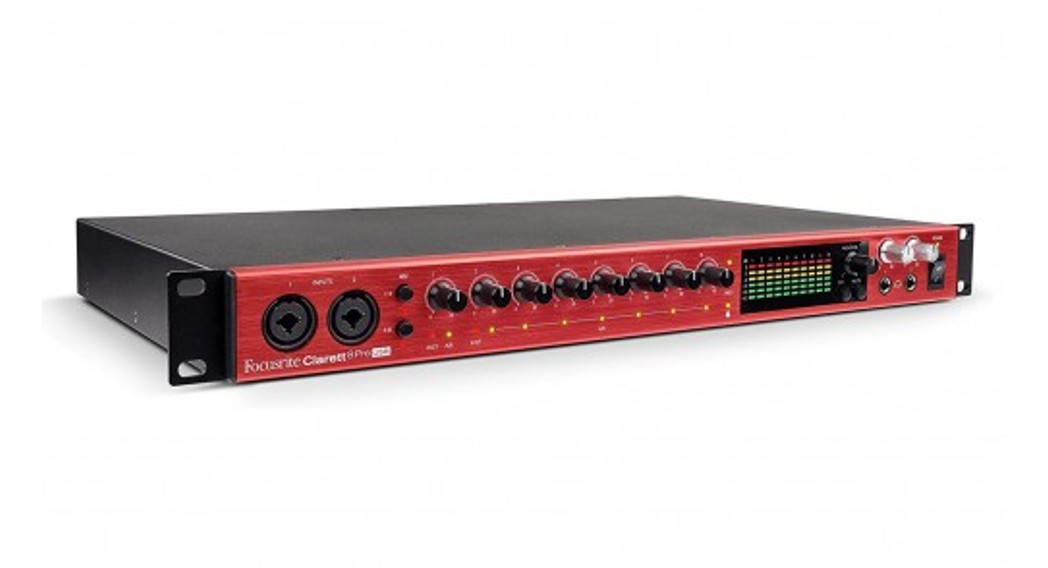
User Guide

Focusritefocusrite.com
Version 2FFFA001253-02
OVERVIEW
WARNING: Excessive sound pressure levels from earphones and headphones can cause hearing loss.
WARNING: This equipment must only be connected to Thunderbolt™ ports.
IntroductionThank you for purchasing this Clarett 8Pre, one of the families of Focusrite professional Thunderbolt™ audio interfaces incorporating newly-designed, high-quality Clarett analog pre-amplifiers with the unique AIR function. In conjunction with the Focusrite Control application, you now have a highly versatile and professional solution for routing high-quality audio to and from your computer recording system, with extremely low latency.
You can also use the Clarett 8Pre as a “stand-alone” interface to any other type of recording device, once you have configured it using Focusrite Control software.
This User Guide provides a detailed explanation of the hardware to help you achieve a thorough understanding of the product’s operational features. We recommend you take the time to read through the Guide, whether you’re new to computer recording or a more experienced user, so you are fully aware of all the possibilities the Clarett 8Pre has to offer.
IMPORTANT: As well as this User Guide, you will need the Focusrite Control Software Guide which can be downloaded from focusrite.com/downloads.This contains full details of Focusrite Control, the software application designed specifically for use with the Focusrite Clarett range of interfaces.
If either User Guide does not have the information you need, please go to support.focusrite.com, where you can find articles and tutorials beyond the scope of this user guide.
FeaturesThe Clarett 8Pre hardware interface provides the means for connecting microphones, musical instruments, line-level audio signals and digital audio signals to a computer through the computer’s Thunderbolt™ port. The signals at the physical inputs can be routed to your audio recording software / digital audio workstation (referred to throughout this user guide as the “DAW”); similarly, the outputs from the DAW can be configured to appear at the unit’s physical outputs.
Audio sources – mics, instruments, etc., can be recorded into your DAW and then played back from there through amplifiers and speakers, powered monitors, headphones, a mixer or any other analog or digital audio equipment you wish to use. Although all inputs and outputs on the Clarett 8Pre are,by default, routed directly to and from your DAW for recording and playback, you can configure the routing any way you like within the Focusrite Control application in order to meet your precise needs. Please see the Focusrite Control user guide for more info on routing.
The Clarett 8Pre also has connectors for sending and receiving MIDI data, and for transmitting word clock to external devices, to ensure synchronization with other items of digital audio equipment.
An important feature of the Clarett 8Pre is the new design of analog preamplifier. In addition to their class-leading dynamic range and ability to provide all the gain, you’re ever likely to need, the circuitry now includes an exciting new AIR function. individually selectable on each channel, AIR subtly modifies the pre-amp’s frequency response to model the impedance and resonance characteristics of Focusrite’s classic transformer-based ISA mic preamps. When recording with good quality microphones, you will notice enhanced clarity and definition in the important mid-frequency range, just where it is most needed for vocals and many acoustic instruments.
The accompanying software application, Focusrite Control, is designed to require a minimal amount of user interaction, letting you easily configure the Clarett 8Pre with signal routings appropriate for the most common recording tasks. For more complex situations, it provides extensive routing and monitoring options, as well as the ability to control global hardware settings such as sample rate and synchronization.
All inputs on the Clarett 8Pre are routed directly to your DAW software for recording, but Focusrite Control also allows you to route these signals internally within the device to the outputs so you can monitor the audio signals with ultra-low latency – before they arrive at your DAW, should you need to do so.
Box ContentsAlong with your Clarett 8Pre you should have:
- AC mains cable with IEC connector
- Important Information, with codes for accessing the following on-line resources:– Focusrite Red 2/Red 3 Plug-in Suite– Optional bundled software.
System RequirementsIMPORTANT – Please visit the following link for up-to-date information on computer and operating system compatibility for all Clarett products: support.focusrite.com
GETTING STARTED
IMPORTANT: Please ensure you install the Focusrite Control before connecting the ninterface to your computer.
Software InstallationAll software required by the Clarett 8Pre, including several powerful and useful extras, is available for download from the Focusrite website (focusrite.com/downloads). The Important Information provided with your Clarett 8Pre contains validation codes if you wish to register your Clarett and access the optional bundled software.
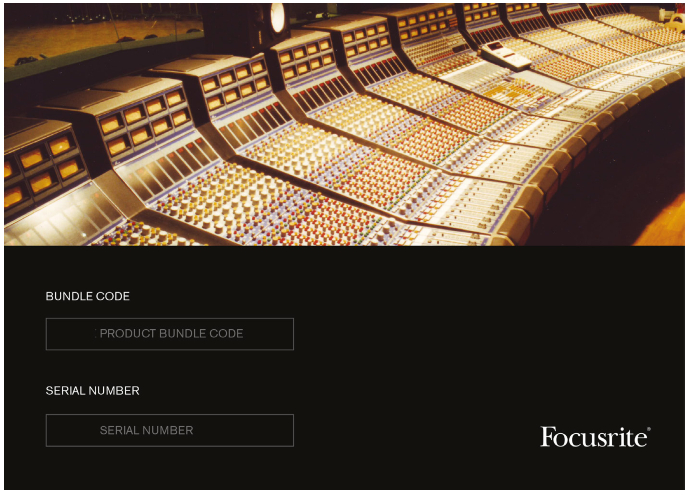
- Using your usual browser, go to focusrite.com/register/.
- Follow the on-screen instructions, entering the “Bundle Code” into the form where prompt your Bundle Code can be found on the Important Information packed with the unit.
- You will then be able to access the “My Products” page, where the software products to which your registration entitles you are available for download, complete with activation codes where applicable
- Download and install the Clarett 8Pre drivers. Follow all on-screen instructions.
- When the installation is complete, you will be prompted to restart your computer.
- After restart, connect the Clarett 8Pre to your computer with a Thunderbolt cable.
- If you are having trouble getting started please watch our video guide here focusrite.com/get-started
Hardware FeaturesFront Panel

The front panel includes all the input gain and monitoring controls as well as two of the input connectors for Mic, Line and Instrument signals.
- INPUTS 1 & 2 – “Combo XLR” input sockets – connect microphones, instruments (e.g., guitar), or line-level signals via XLR or ¼” jacks as appropriate. Either TRS (balanced) orTS (unbalanced) jack plugs can be used for instruments or line-level signals.
- 48V – two switches enabling 48 V phantom power at the XLR contacts of the Combo connectors for mic inputs 1-4 and 5-8 respectively. (Note inputs 3 to 8 are on the rear panel.) The switches each have an associated red LED indicating phantom power is selected.
- Gain 1 to 8 – eight rotary controls: adjust the input gain for the signals at Inputs 1 to 8 respectively.
- INST – two red LEDs which illuminate when INST mode is selected for the jack contacts of Inputs 1 or 2 from Focusrite Control software. When INST is selected, the gain range and input impedance are altered (relative to LINE), and the input is made unbalanced. This optimizes it for the direct connection of instruments via a 2-pole (TS) jack plug. When INST is off, the inputs are suitable for the connection of line-level signals. Line level signals may be connected either in balanced form via a 3-pole (TRS) jack or unbalanced, via a 2-pole (TS) jack.
- AIR – eight yellow LEDs – one per input – which illuminate when the AIR function is selected for the input from Focusrite Control. AIR modifies the frequency response of the input stage to model the classic, transformer-based Focusrite ISA mic preamps.
- Meters – ten 6-segment LED bargraph meters indicating a) the signal levels of the eight analogue input signals (meters 1 to 8), and b) the signal levels at the MONITOR 1 and 2 outputs (meters L and R). The input meters show signal level after the input gain stage, and thus their indication is affected by the gain controls. The output meters show signal level before the monitor level control [10], which therefore does not affect their indication. The LEDs illuminate at -42 (green, “signal present”), -18 and -12 dBFS (green), -6 and -3 dBFS (yellow) and 0 dBFS (red). A level of 0 dBFS implies digital clipping, and should always be avoided.
- – a green LED which illuminates when the unit has established a connection with the computer to which it is connected.
- MIDI – a green LED which illuminates when MIDI data is being received at the rear panel MIDI IN port.
- LOCKED – a green LED that confirms clock synchronization, either to the Clarett 8Pre’s internal clock or to external digital input.
- MONITOR – main monitor output level control – this control will normally control the level at the main monitor outputs on the rear panel, but can be configured in Focusrite Control to adjust the level of any of the unit’s ten analog outputs.
- DIM and MUTE – two switches controlling the Clarett 8Pre’s monitor outputs; DIM reduces the output levels by 18 dB, while MUTE turns the outputs off. By default, these switches affect the main monitor outputs 1 and 2, but maybe configured in Focusrite Control to act on any of the analog outputs. The switches are internally illuminated (DIM: yellow, MUTE: red) indicating the function is selected.
- HP1 and HP2 – connect one or two pairs of stereo headphones at the two ¼” TRS jack sockets below the controls. The headphone outputs always carry the signals currently routed to analog outputs 7/8 and 9/10 (as stereo pairs) in Focusrite Control.
- POWER – AC power switch and LED.
- Rack ears for mounting the Clarett 8Pre in a standard 19” equipment rack.

- MIC/LINE INPUTS 3 to 8 – “Combo XLR” input sockets – connect further microphones or line-level signals via XLR or ¼” jacks as appropriate. Either ¼” TRS (balanced) or TS (unbalanced) jack plugs can be used for line-level signals.
- LINE OUTPUTS 3 to 10 – eight balanced analog line outputs on ¼” jack sockets; use TRS jacks for a balanced connection or TS jacks for unbalanced. The signals routed to these outputs are defined in Focusrite Control, and can typically be used for driving alternative speakers (i.e., midfield, nearfield, etc.), the additional speakers in a multichannel monitoring system, or to send audio to outboard FX processors.
- MONITOR 1 and 2 – two balanced analog line outputs on ¼” jack sockets; use TRS jacks for a balanced connection or TS jacks for unbalanced. These are also Line Outputs 1 and 2 of the system, and will generally be used for driving the main L and R speakers of your monitoring system. However, the routing of signals to outputs may be customized in Focusrite Control.
- OPTICAL IN and OUT – two TOSLINK connectors, each carrying eight channels of digital audio in ADAT format at 44.1/48 kHz sample rate, four channels at 88.2/96 kHz or two channels at 176.4/192 kHz. These are additional inputs and outputs (respectively) to/from the Clarett 8Pre. The OPTICAL IN connector may alternatively be configured to receive a two-channel S/PDIF signal, up to 96 kHz sample rate, from an external source equipped with an optical S/PDIF output. This option is selected from Focusrite Control.
- WORD CLOCK OUTPUT – a BNC connector carrying the Clarett 8Pre’s word clock; this may be used to synchronize other digital audio equipment forming part of the recording system. The source of sample clock synchronization used by the Clarett 8Pre is selected in Focusrite Control.
- – Thunderbolt™ connector; connect the Clarett 8Pre to your computer with a suitable Thunderbolt™ cable.
- MIDI IN and MIDI OUT – standard 5-pin DIN sockets for connection of external MIDI equipment, allowing MIDI data to/from your computer to be received and distributed to additional MIDI devices.
- SPDIF IN and OUT – two phono (RCA) sockets carrying two-channel digital audio signals in or out of the Clarett 8Pre in S/PDIF format. Like all the other inputs and outputs, the routing of S/PDIF signals may be customized in Focusrite Control. The S/PDIF inputs are functional up to 96 kHz sample rate.
- AC mains – standard IEC receptacle. The Clarett 8Pre is fitted with a “Universal” power supply and will run from any AC mains voltage from 100 to 240 V, at 50 or 60 Hz.
Connecting your Clarett 8PreIMPORTANT: Before you connect the Clarett 8Pre to your computer, please complete the software installation according to the instructions on page 5. This will ensure the hardware uses the correct drivers and will prevent unexpected behavior.
The Clarett 8Pre should be connected to AC mains with the supplied AC power cable. Plug the IEC connector into the rear panel IEC port and turn the unit on with the front panel power switch.
The Clarett 8Pre has a Thunderbolt™ port (on the rear panel). Once the software installation is complete, connect the Clarett 8Pre to your computer using a Thunderbolt™ cable.
Computer audio setupYour OS should automatically select the Clarett 8Pre as the default audio device. You can check this selection has been made correctly if you wish. Details of how to do this on various operating systems can be found at focusrite.com/clarett8Pre-getstarted.
Audio Setup in your DAWAfter installing the drivers and connecting the hardware, you can start using the Clarett 8Pre with the DAW of your choice.
Please note – your DAW may not automatically select the Clarett 8Pre as its default I/O device. In this case, you must manually select the driver on your DAW’s Audio Setup* page, and select the Focusrite Thunderbolt driver. Please refer to your DAW’s documentation (or Help files) if you are unsure where to select the Clarett 8Pre as your audio device.* Typical name – page names may vary with DAW
Connecting Clarett 8Pre to loudspeakersThe 1/4” jack MONITOR outputs on the rear panel (Line Outputs 1 and 2) will normally be used to drive monitoring speakers. Self-powered monitors (e.g., typical computer speakers) incorporate internal amplifiers and may be connected directly. Passive loudspeakers will require a separate stereo amplifier; in this case, the rear panel outputs should be connected to the amplifier’s inputs.

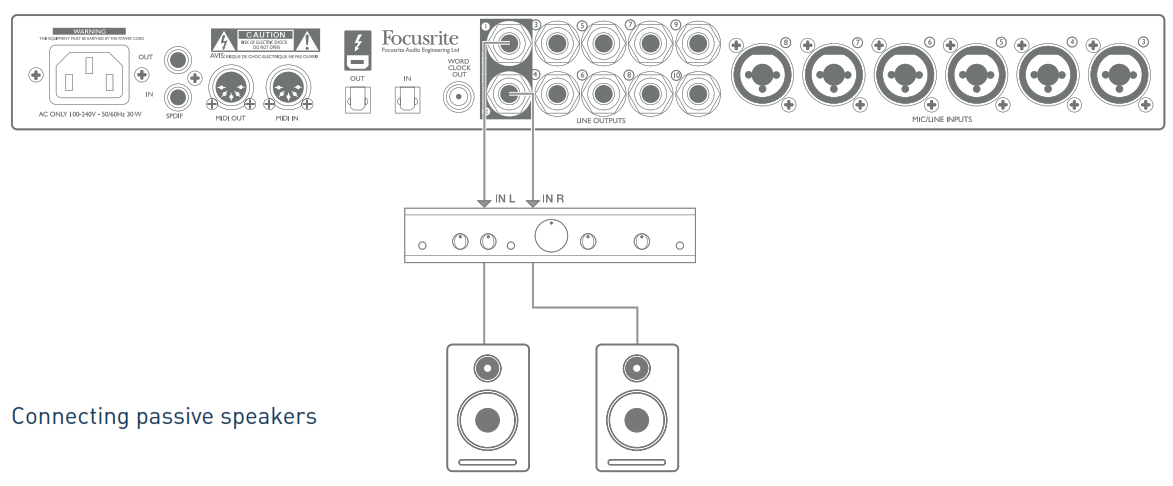
All the line output connectors are 3-pole (TRS) ¼” jack sockets and are electronically balanced. Typical consumer (hi-fi) amplifiers and small powered monitors will have unbalanced inputs, either on phono (RCA) sockets or via a 3.5 mm 3-pole jack plug intended for direct connection to a computer. In either case, use a suitable connecting cable with jack plugs at one end.
Professional power amplifiers will generally have balanced inputs.
When mixing, you can connect several pairs of additional speakers (mid-field. near-field, etc.) to pairs of outputs and use Focusrite Control to route your mix to the different outputs as desired, to check your mix on the different types of speaker.
Examples of UsageThe Clarett 8Pre is an excellent choice for numerous recording and monitoring applications. Some typical configurations are shown below.
1. Recording a band
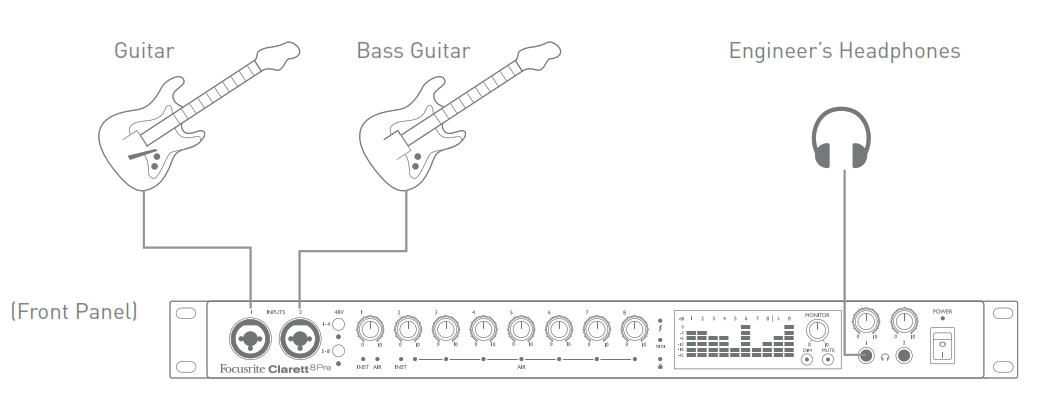
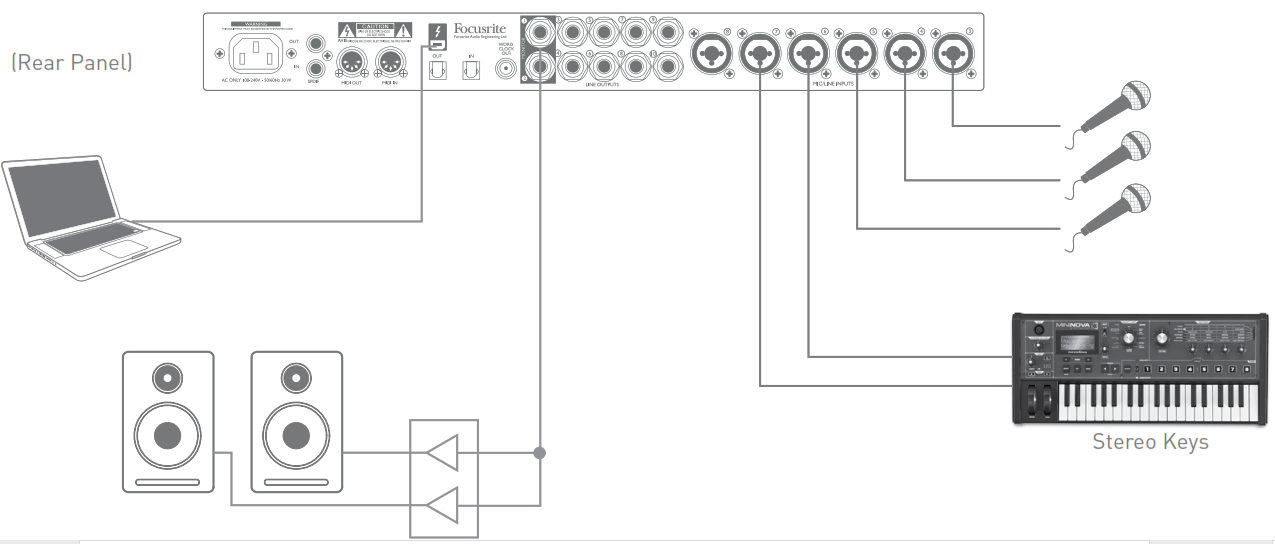
This setup illustrates a typical configuration for multitrack recording with DAW software on your computer.
A selection of sources – microphones, two guitars, and a keyboard – is shown connected to the Clarett 8Pre’s inputs. Note that only Inputs 1 and 2 can be configured to accept instruments directly, so we have chosen to plug the guitars into Inputs 1 and 2. Ensure INST mode is selected for Inputs 1 and 2 from Focusrite Control, and the INST LEDs are illuminated.
The connection to the computer running DAW software is via a Thunderbolt™ cable. This will carry all the input and output signals between the DAW and the Clarett 8Pre. Once the audio setup is correctly configured in the DAW, each input source will be automatically routed to its own DAW track for recording.
A note about latencyYou will probably have heard the term “latency” used in connection with digital audio systems. In the case of the DAW recording application described above, latency is the time it takes for your input signals to pass through your computer and audio software, and back to you. Latency is rapidly becoming a problem of the past; the Thunderbolt™ interface used by your Clarett 8Pre is much faster than the USB or FireWire interfaces you may have used previously. As a result, you will nearly always be able to monitor your recordings through your DAW without noticing latency.
There are two possible exceptions to this: one is when you need to set the recording buffer size to a high value – this may be necessary when you are recording overdubs on a, particularly large session with many audio channels, software instruments and effects, for example. To overcome this, Focusrite Control gives you the option of sourcing your monitor feed directly from the Clarett 8Pre’s inputs. Another situation where “Input Monitoring” may need to be selected is when you are recording several live musicians simultaneously, and they each require their own custom foldback mix. Focusrite Control lets you define up to eight separate stereo mixes (or sixteen mono mixes), and these mixes may include the current input signals as well as previously recorded DAW tracks.
When sourcing monitor mixes from input signals in this way, ensure the DAW channels you are recording are muted, otherwise the musicians will hear themselves “twice”, with one signal audibly delayed as an echo.
Please refer to the Focusrite Control User Guide for more details on setting up monitor mixes.
2. Using the optical connectionsIn addition to the eight analog inputs, the Clarett 8Pre has an ADAT input port (OPTICAL IN) which can provide an additional 8 audio inputs at 44.1/48 kHz sample rate, four at 88.2/96 kHz or two at 176.4/192 kHz. Using a separate 8-channel microphone preamplifier equipped with an ADAT output– such as the Focusrite OctoPre – provides a method of expanding the Clarett 8Pre’s input count.
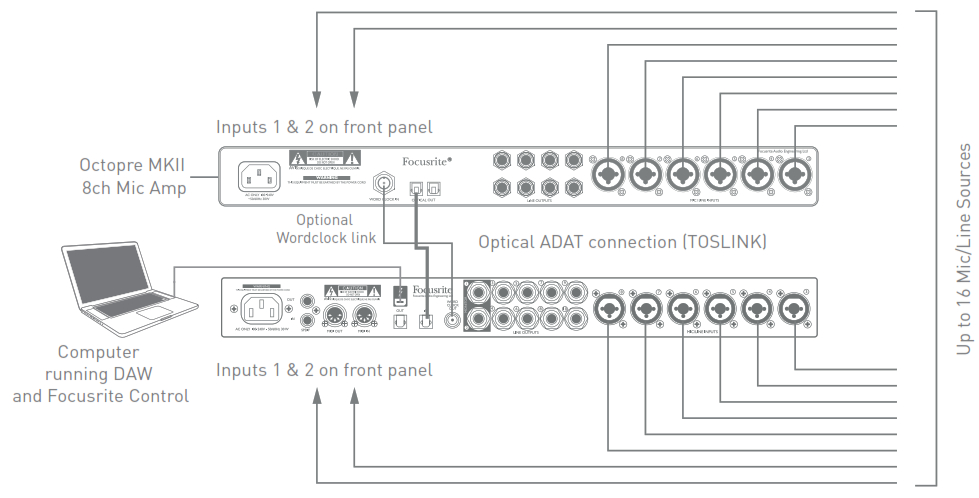
The OctoPre’s OPTICAL OUT port is connected to the Clarett 8Pre’s OPTICAL IN port with a single TOSLINK optical cable. Stable word clock synchronisation may be achieved by connecting the Clarett 8Pre’s WORD CLOCK output to the OctoPre’s WORD CLOCK IN and setting the OctoPre to use this as its sync source; alternatively, the Clarett 8Pre may be set (in Focusrite Control) to synchronize via the ADAT format signal at the OPTICAL IN port.
Note: when interconnecting two digital devices by any method, always ensure both are set to use the same sample rate.
The additional inputs from the optical port may be routed using Focusrite Control in exactly the same way as the other inputs. The additional inputs can form part of any musician’s headphone mix, as required.
If a suitable D-to-A converter with an ADAT input is available, the OPTICAL OUT port may be used in the opposite way; for example, additional outputs from the DAW may be converted into the analog domain to allow the use of external hardware mixing console to mix down a large number of DAW tracks.
3. Using the Clarett 8Pre as a stand-alone mixerThe Clarett 8Pre has the ability to store a mixed configuration defined in Focusrite Control within the hardware. This feature lets you configure it – for example, as an on-stage keyboard mixer – using your computer, and then upload the configuration to the device itself. Then you can use the Clarett 8Pre as a rack-mounting mixer as part of your keyboard rig to control the overall mix of multiple keyboards.
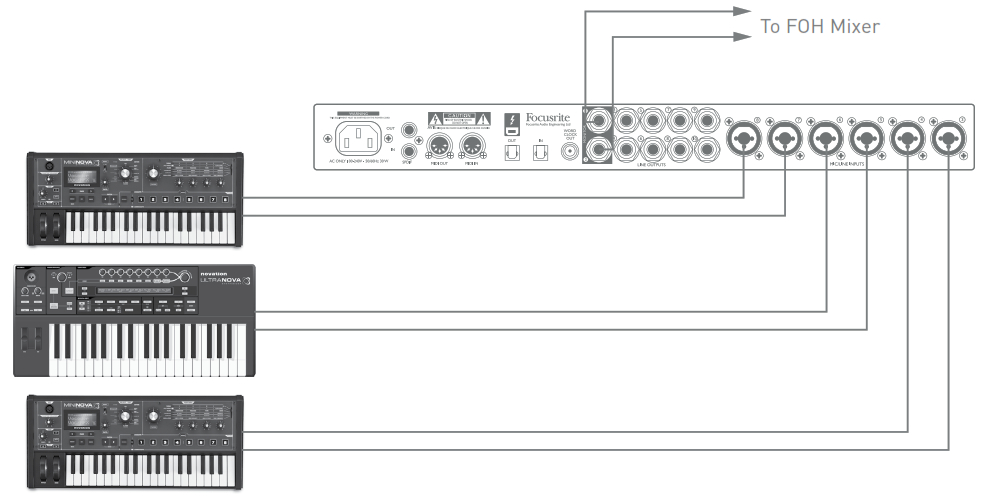
In the example above, three stereo keyboards are connected to the rear panel inputs of the Clarett 8Pre; Outputs 3 and 4 go to the main PA system. The performer can adjust the volume of the individual keyboards from the front panel; he/she can also independently adjust the level they hear the mixed keyboards at through the speakers.
4. Loopback RecordingFocusrite Control’s Loopback feature lets you record other audio sources from within your computer(e.g., the audio output from a web browser). Loopback uses Clarett’s “virtual” inputs, which have no physical connectors on the hardware interface itself but may be selected in the DAW as signal sources for recording.
By routing DAW 1 and 2 to your Loopback mix in Focusrite Control, when you select the Loopback output as the recording source on a mono or stereo DAW track, you can record from another software application into your DAW. Note that your computer will assign DAW 1 and DAW 2 as the default sound output channels.
For instructions on how to use the Loopback recording function, please see the Focusrite Control Clarett User Guide available from:
FOCUSRITE CONTROL – OVERVIEW
Focusrite Control is the software application used with the Clarett 8Pre. It allows you to create a custom monitor mix for each musician, and also to specify the routing of all audio signals to the physical audio outputs. All sample rate selection, digital syncing and buffer size settings (Windows only) are available from Focusrite Control.
Note: Focusrite Control is also used with other hardware interfaces in the Focusrite range. When you connect an interface to your computer and launch Focusrite Control, the model of the interface is automatically detected, and the software configured to suit the number of inputs and outputs, and other features, available on the hardware.
Focusrite Control has its own, dedicated User Guide, which contains detailed operating instructions for all aspects of the software. This may be downloaded from Focusrite/downloads.
CLARETT 8PRE TECHNICAL SPECIFICATIONS
Performance Specifications
| Configuration | |
| Inputs | 18: analogue (8), S/PDIF (2), ADAT (8) |
| Outputs | 20: analogue (10), S/PDIF (2), ADAT (8) |
| Mixer | Fully assignable 30-in/16-out mixer |
| Digital Performance | |
| Supported sample rates | 44.1 kHz, 48 kHz, 88.2 kHz, 96 kHz, 176.4 kHz & 192 kHz |
| Microphone Inputs | |
| Frequency Response | 20 Hz – 20 kHz +/-0.1 dB |
| Dynamic Range | 118 dB (A-weighted) |
| THD+N | 0.001% |
| Noise EIN | –128 dBu (A-weighted) |
| Maximum input level | +18 dBu |
| Gain Range | 57 dB |
| Impedance | AIR Off: 6.2k Ω – AIR On: 2.2k Ω |
| Line Inputs | |
| Frequency Response | 20 Hz – 20 kHz +/-0.1 dB |
| Dynamic Range | 118 dB |
| THD+N | 0.005% |
| Maximum input level | +26 dBu |
| Gain Range | +57 dB |
| Impedance | >50k Ω |
| Instrument Inputs | |
| Frequency Response | 20 Hz – 20 kHz +/-0.1 dB |
| Dynamic Range | 111 dB (A-weighted) |
| THD+N | 0.001% |
| Maximum input level | +14 dBu |
| Gain Range | +57 dB |
| Impedance | >2M Ω |
| Line & Monitor Outputs | |
| Dynamic Range (line outputs) | 119 dB |
| Dynamic Range (monitor outputs) | 117 dB |
| THD+N | 0.0007% |
| Maximum Output Level (0 dBFS) | +18 dBu, balanced |
| Headphone Outputs | |
| Dynamic Range | 112 dB |
| THD+N | 0.0008% |
| Maximum Output Level | +16 dBu |
Physical and Electrical Characteristics
| Analogue Inputs 1 & 2 | |
| Connectors | “Combo XLR” sockets: Mic/Line/Inst, on front panel |
| Mic/Line switching | Automatic |
| Line/Instrument switching | via Focusrite Control |
| Phantom power | +48 V switches for inputs 1 to 4, 5 to 8 |
| Analogue Inputs 3 to 8 | |
| Connectors | “Combo XLR” sockets: Mic/Line, on rear panel |
| Mic/Line switching | Automatic |
| Phantom power | +48 V switches for inputs 1 to 4, 5 to 8 |
| Analogue Outputs | |
| Main outputs | 10 x balanced ¼” TRS jacks (on rear panel) |
| Stereo headphone outputs | 2 x ¼” TRS jack on front panel |
| Main monitor output level control |
On front panel |
| Headphones level controls | |
| Other I/O | |
|
ADAT I/O |
2 x TOSLINK optical connectors: 8 channels at 44.1/48 kHz
4 channels at 88.2/96 kHz 2 channels at 176.2/192 kHz |
| S/PDIF I/O | 2 x phono (RCA); can be re-assigned to ADAT ports in software. Supported at 44.1/48/88.2/96 kHz sample rates. |
| Word clock output | BNC connector |
| Data connector (to Mac) | 1 x Thunderbolt connector |
| MIDI I/O | 2 x 5-pin DIN sockets |
| Weight and Dimensions | |
| W x D x H | 482.5 mm x 43.9 mm x 291 mm 19” x 1.73” x 11.46” |
| Weight | 4.35 kg
9.59 lbs |
TROUBLESHOOTING
For all troubleshooting queries, please visit the Focusrite Help Centre at support.focusrite.com.
COPYRIGHT AND LEGAL NOTICES
Focusrite is a registered trademark and Clarett 8Pre is a trademark of Focusrite Audio Engineering Limited.All other trademarks and trade names are the property of their respective owners.2015 © Focusrite Audio Engineering Limited. All rights reserved.
References
[xyz-ips snippet=”download-snippet”]

